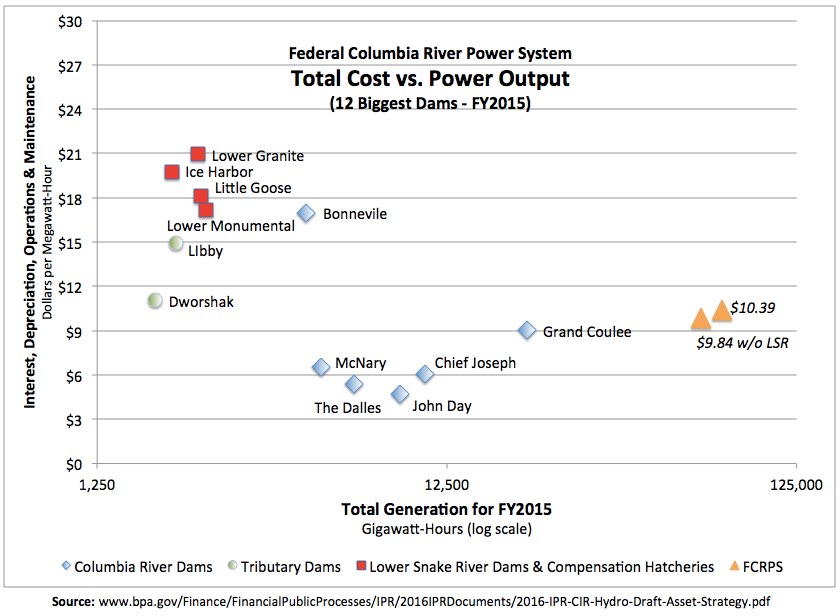forum
library
tutorial
contact

Snake River Dam Agreement
Challenged by Public Power Council
by Annette Cary
Tri-City Herald, January 29, 2024
|
the film forum library tutorial contact |

|
Snake River Dam Agreement
by Annette Cary
|
 Kennewick, WA -- The Bonneville Power Administration is being challenged in the U.S. 9th Circuit Court of Appeals after it signed an agreement that's being called a roadmap for breaching the Snake River dams in Eastern Washington.
Kennewick, WA -- The Bonneville Power Administration is being challenged in the U.S. 9th Circuit Court of Appeals after it signed an agreement that's being called a roadmap for breaching the Snake River dams in Eastern Washington.
A petition for the court to review the agreement was filed by the Public Power Council, which represents consumer-owned electric utilities relying on Columbia and Snake River hydropower. Those include the Benton and Franklin PUDs and the Benton REA.
The agreement signed Dec. 13 includes measures to restore Columbia and Snake River salmon and steelhood and includes funding to study or replace the energy, transportation, irrigation and recreation services provided by the four lower Snake River dams, paving the way for dam breaching.
The power council is concerned that the memorandum of understanding signed by BPA Administrator John Hairston has the potential to result in cost increases or grid reliability issues.
Signatories included BPA along with other federal agencies, plus Oregon, Washington state and four Northwest tribes.
Although the agreement does not directly call for breaching the four Eastern Washington dams from Ice Harbor near Pasco to Lower Granite near Lewiston, Idaho, it does repeatedly raise the possibility and calls for studies on how benefits might be replaced.
The agreement also calls for the Department of Energy to assist the four lower Columbia River tribes -- the Yakama, Umatilla, Nez Perce and Warm Springs -- in developing tribally sponsored clean energy projects that could help replace hydropower lost if the dams are breached.
Commitments made in the agreement are estimated to cost the federal government more than $1 billion.
The power council questions whether the memorandum of understanding exceeds the authority BPA has under law to market federal hydropower by straying into work that could lead toward removal of the dams that produce that hydropower.
The memorandum of understanding also commits BPA to spend an additional $300 million on habitat restoration to help endangered salmon and steelhead and spells out how much water must be spilled over dams to benefit juvenile salmon rather than being used to produce electricity.
Despite the far-reaching implications of the document Hairston signed, BPA held no public process to consider it or to solicit input from electric ratepayers who could be affected by the agreement, the power council said.
"At the heart of our petition is the principle of transparency and fairness in BPA's decision-making process and regulatory proceedings," said Scott Sims, executive director of the power council. "BPA's failure to publicly disclose and explain the MOU and its terms under this U.S. government agreement underscores the need for judicial oversight to uphold the interests of public power utilities and the communities they serve."
Because of the appeal to the 9th Circuit, BPA must now prepare and file its administrative record and explain its position in legal pleadings.
The power council is asking the court to review any actions that contributed to the BPA's decision to enter into the agreement.
It wants BPA to be required to engage with ratepayers or others who are affected before making important decisions, incurring significant costs or making other significant changes to the operation of Columbia and Snake rivers system hydroelectric dams.
It also wants certainty on costs of BPA's obligations under the agreement as it is negotiating long-term contracts.

The Northwest needs more electric negotiations and the goals of tribal development of new clean energy sources are laudable, according to the council.
But there are concerns about possible requirements or pressure for BPA to buy power from those projects, no matter the price. If BPA loses the steady power from the dams and has it replaced by intermittent sources, such as solar, there could be an additional expense of paying for steady power to back that up.
The series of storms in mid January caused the highest electricity demand from BPA power since the Northwest's high electric use aluminum plants shut down.
Hydropower made up 70% of the Northwest's electric supply then. The lower Snake River dams produced 1,000 megawatts or more of electricity on average during the highest electric demand hours of the cold snap, or enough to power about 1 million households.
For much of the cold snap wind power projects were at nearly zero production, according to the power council.
"Here in the Northwest, this recent, long-duration cold weather event is yet another strong reminder of just how essential our hydropower resources are," Simms said.
Other parties are expected to file their own petitions of review or join the power council in its appeal in the coming weeks.
A spokesperson for BPA said the agency was aware of the filing in the 9th Circuit but does not comment on pending litigation.
learn more on topics covered in the film
see the video
read the script
learn the songs
discussion forum
